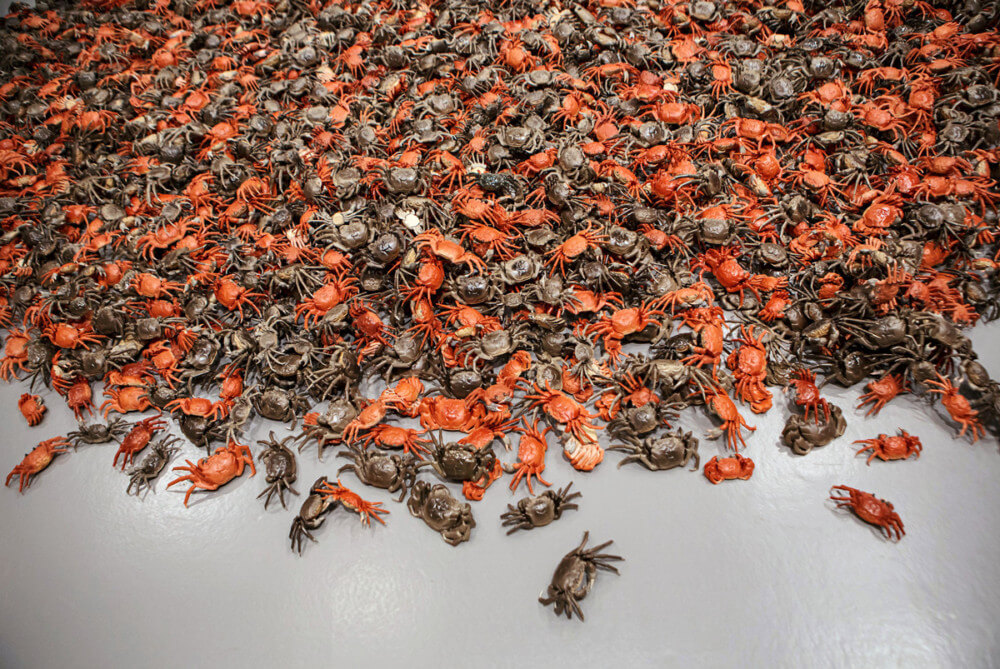The headline above was taken from Salon‘s review (February 28, 2013) of the exhibition, Ai Weiwei: According to What?, at the Hirschhorn Museum in Washington DC, the beginning of its North American tour. It has just closed in Toronto and is headed to Miami’s new Perez Art Museum, in time for the art-lemmings descent on the Basel Miami Fair, and then to the Brooklyn Museum in the spring.
The exhibition is a full-scale survey of this dissident’s wide-ranging art. An important part of his oeuvre is his interaction with ceramics. The media has picked up on this, perhaps because of its populist edge. The three most reproduced images for the exhibition’s reviews and publicity are: Dropping a Han Dynasty Urn, 1995/2009; Colored Vases, 2007-10 (Neolithic vases that have been painted by Ai); and He Xie, 2010 (3,200 trompe-l’oeil painted porcelain crabs).
The latter are, by far, the most popular. He Xie encourages humorous punning captions and headlines, dazzles because of the skill of their manufacture and gives a mild shock, as an advancing decapodal army of creepy crustaceans would. Any Mainland Chinese viewer would understand Ai’s game immediately.
The artwork is an homage to Ai’s departed Shanghai studio which the authorities decided to raze in punishment for Ai’s activism. To mourn its impending demolition, Ai invited five hundred guests to a huge crab fest at the studio on November 7, 2010. (See video of the party below). Ten thousands crabs were consumed that day, but minus Ai. He was placed under house arrest the day before in Beijing and released the day after to prevent his attendance. Shortly afterwards, bulldozers arrived and demolished his extensive complex that has been originally been paid for by the city of Shanghai.
The contextual claw in this work is its title, He Xie, as critic Michael Wine reminds us, “it is a sly reference to the Mandarin word that means both river crab and harmonious. Among critics of China’s censorship regime, hexie has become a buzzword for opposition to the government’s call to create a harmonious society, free from dissent.” To the country’s dissidents is this means censorship and suppression of individuality.
With Ai, not even a food menu is free of activism, albeit subtle and of little meaning to the West. This piece is for in-home consumption. Do try and see the show in Miami or in New York. As a final footnote, CFile Chief Editor Garth Clark has just finished his book Mind Mud: The Conceptual Ceramics of Ai Weiwei that will be published next year by Thames and Hudson, London.

Ai Weiwei, He Xie, 2010. 3200 trompe-l’oeil painted porcelain crabs. Installation at the Hirschhorn Museum and Sculpture Garden, Washington, DC.
 Installation view of Ai Weiwei: According to What? at the Hirshhorn Museum and Sculpture Garden, Washington D.C., 2012. From top to bottom: Dropping a Han Dynasty Urn, 1995/2009; Colored Vases, 2007-2010. Photo: Cathy Carver
Installation view of Ai Weiwei: According to What? at the Hirshhorn Museum and Sculpture Garden, Washington D.C., 2012. From top to bottom: Dropping a Han Dynasty Urn, 1995/2009; Colored Vases, 2007-2010. Photo: Cathy Carver
 Ai Weiwei, Colored Vases, 2007-2010.
Ai Weiwei, Colored Vases, 2007-2010.
Video of Ai Weiwei’s River Crab Feast held at his Shanghai studios on November 7th, 2010, the day before the government tore the structure down as punishment for his activism.
Read the full review in Salon
Visit the Hirschhorn

Add your valued opinion to this post.